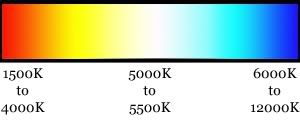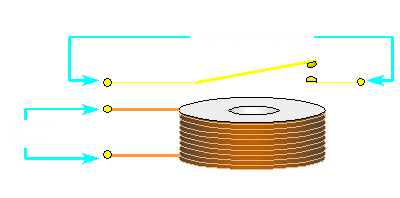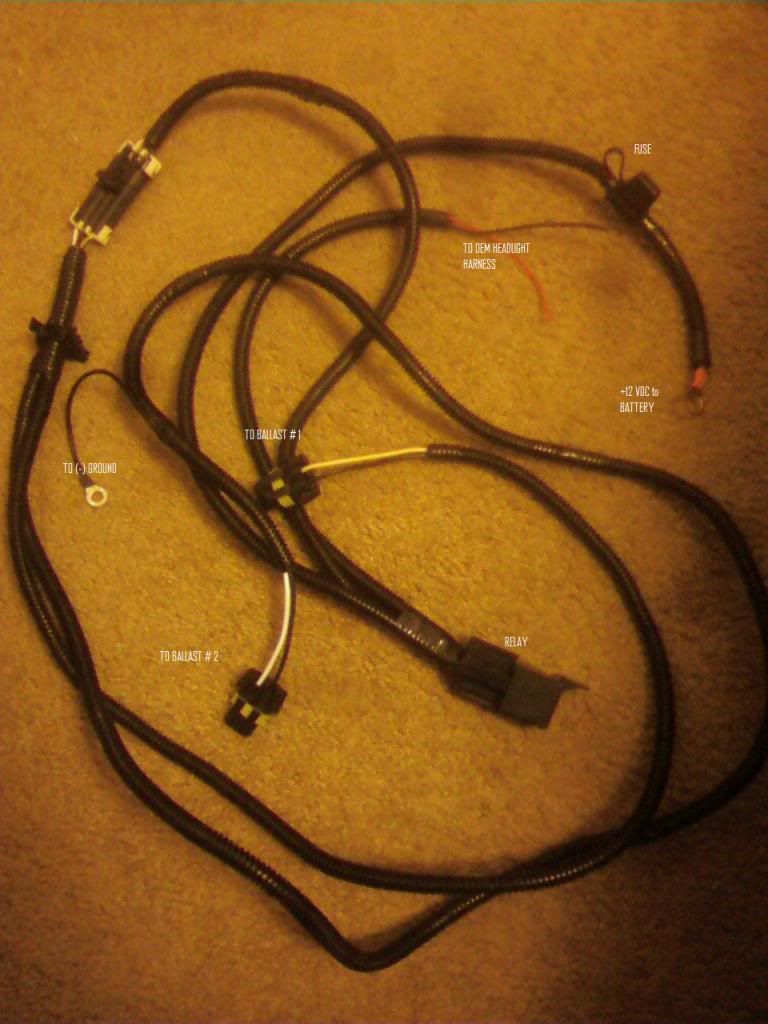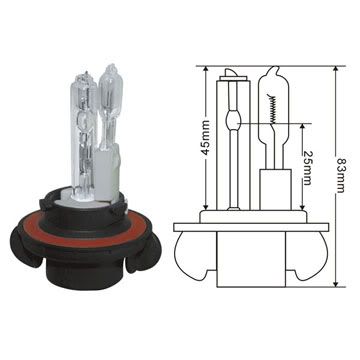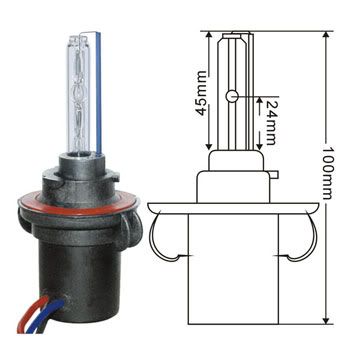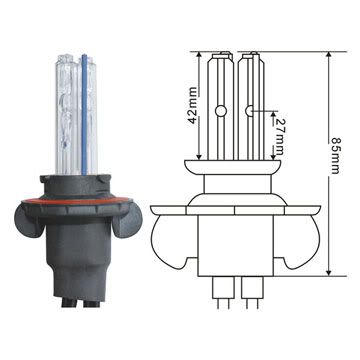OK, lately I've seen a LOT of people with 97-03 and 04+ model Grand Prix's post a lot of questions, comments and confusion about HID's. There is The Ultimate HID Thread on this forum but I'll try to condense all the pertinent info down as simply and clearly as I can.
KELVINS
There is a lot of confusion here. The Kelvin scale is the warmth of the COLOR that the HID bulb puts out, not the temperature of the bulb.
As the above chart shows, 3000 to 4000 K is a yellow-ish color, 5000 K is almost pure white with just a hint of blue, 6000 K is light blue and 10,000 + K is very dark blue.
LUMENS
Lumens are the amount of usable light put out by the HID bulb. 4100-4300 K has the most usable light output. Most manufacturers will have different ratings per each bulb color but 4300 K is generally around 3000-4000 lumens depending on manufacturer specs and the wattage of the HID system (35 watt versus 50 or 55 watt, discussed later). If you go higher than 4300 K you start to lose usable light, though not much compared to a typical halogen bulb, but enough to make a 12,000 K bulb (deep blue) merely a cosmetic choice.
WATTAGE
The most common wattage for an HID system is 35 Watts. Each ballast uses 35 Watts, which is much less than the standard 55 Watt halogen bulb. 35 Watt systems are offered by a wide variety of manufacturers for aftermarket installations and the majority of OEM installations are still 35 Watts. 55 Watt systems are now more available and their price for aftermarket installations is dropping, almost so much that they are now comparable in price to 35 Watt systems. 55 Watt systems do put out more light than 35 Watt systems but from personal experience it isn't that much. Wattage is really a personal preference.
CURRENT
While HID systems use less Wattage than the typical halogen bulb, there is a brief start-up current that each ballast draws. A 55 Watt halogen bulb will pull pretty much the same amount of current from the time it is turned on until it is turned off which is about 4.58 Amps per bulb. That is 55 Watts / 12 Volts = 4.58 Amps. Of course, each headlight system will vary from car to car as far as the amount of resistance in the headlight harness to the amout of voltage the battery is putting out at any given time. Nonetheless, 4-5 Amps per halogen bulb is typical. An HID ballast, however, draws much more current at start-up than a halogen bulb will consume at full output. I've had a variety of HID systems on each of my cars and all of them have different ratings but the start-up current typically ranges from 8-15 Amps per ballast. Since most 55 Watt halogen headlight systems only consume 4-5 Amps per side (8-10 per headlight harness) you could potentially be pulling anywhere from 16-30 Amps of current from your stock headlight harness at start-up. This may result in the blowing of a lowbeam fuse or the flickering of an HID bulb at start-up. Constant flickering of an HID bulb at start-up will eventually kill the bulb and/or ballast. So how can you overcome this problem of high start-up current? Use a relay harness.
RELAY HARNESS
What exactly is a relay harness? To try to put it simply, a relay harness uses the voltage from the stock OEM headlight harness to turn on a relay, when the relay is energized it closes a contact (like how a lightswitch works) that brings power straight from the battery.
Relay harness:
^^^Above is a picture of a home-built relay harness. Essentially, the (-) ground goes to the chassis ground of the car, the +12 VDC connector goes to the positive terminal of the car's battery and the other 2 wires plug into the OEM headlight harness (I don't have a connector on it because this is an extra harness that I don't have a use for...at the moment). The two plugs marked "Ballast # 1" and "Ballast # 2" are self explanatory. This harness allows both HID ballasts to draw all the current that they need to safely and efficiently start-up and run.
So, what about those HID kits that say they're plug and play? Well, they will work (probably) but they will most likely take longer to reach full light output and you will more than likely need to replace a ballast/bulb/entire kit within a few months. If you have a lifetime warranty and don't mind swapping out HID components frequently this won't bother you but why put up with this? Most HID vendors offer relay harness' for about $30 or you could stop being a pansy and make one yourself for about $20.
DRL'S TO DISABLE OR NOT TO DISABLE
If it just so happens that you have DRL's and they are your headlights it is imperative that you disable the DRL's. The reason for this is that most DRL's run at a lower voltage to dim the output of the lights. Some even reverse the polarity of the headlights to run the DRL's like my 2001 Aurora did, though disabling the DRL's was quite simple. As a result the ballasts cannot get the proper voltage which means you'll fry them. Even if you decide to use a relay harness the DRL's won't put out enough voltage to keep the relay coil activated which means that the whole installation won't operate. There is enough info on this site to show you how to disable DRL's for a 97-03 GP and most of us 04+ GP guys can simply turn off the DRL's with our headlight switch before we shift into gear.
HID'S FOR HEADLIGHTS...HOW ABOUT FOR FOGS AND HIGHBEAMS?
The most common HID install is for the headlights since they are the most often used lighting on your vehicle for night-time illumination. Adding HID's to fogs is becoming more common and is generally similar to adding them to the headlights. The only problem is that if you have them on at night and you use the flash-to-pass your fogs will go out each time you activate the highbeams. Blinking HID's on and off is bad for the bulbs and is not recommended, keep that in mind for HID fogs.
Highbeam HID's, while blindingly bright, are not very useful or practical. If you have separate highbeams and lowbeams (i.e. 9006 low, 9005 high) you shouldn't put HID's in the highbeams because of how intermittently they are used. Not to mention the fact that HID's take longer to reach full intensity than a halogen bulb so if you use the flash-to-pass feature most drivers won't really notice you hopelessly flickering your highbeams at them. This flickering will also eventually ruin the bulbs and/or the ballasts. If you have a 9004, 9007 or other dual filament halogen, combination low/highbeam headlight system you have a few options...97-03 GP guys I'm talking to you.
BI-XENON, 9007-1, 9007-2, 9007-3, 9007-4
For those of you with 9007 headlights there are options for you. The first is the 9007-1 option. This essentially eliminates the highbeam completely. You will have only an HID lowbeam, this is the simplest HID system to install but you now have no highbeam.
9007-2 is an HID lowbeam with a halogen highbeam bulb built into the base. Usable light is negligable as the HID lowbeam will overpower the highbeam.
^^^H13-2 (9007-2 similar)
9007-3 utilizes a single HID bulb for the lowbeam and the highbeam. This is accomplished by either tilting the HID bulb into the highbeam position or retracting the bulb into the base into the correct position. Both are accomplished using a solenoid built into the base of the bulb. This system is the most reliable and usable IF the position of the light source (xenon chamber of the bulb) matches the position of the OEM halogen filament in the headlight housing. If not, the light will be scattered all over the place essentially making the highbeam into a blinding, glare-monster. This, however, is a fairly expensive set-up to run.
^^^H13-3 (9007-3 similar)
9007-4 uses two HID bulbs in one base. The major disadvantage to this is that you need TWO ballasts per BULB so you'd have FOUR total ballasts for this set-up. Cost and the aforementioned problems with the flash-to-pass arise with the 9007-4 set-up.
^^^H13-4 (9007-4 similar)
GLARE
Glare is a common problem reported with HID systems. A lot of the first HID systems were terrible for putting out glare. This was generally because the HID bulb's xenon chamber didn't correctly line up with that of the OEM halogen's filament. As a result light was scattered all over the place blinding oncoming drivers. This is why a lot of states, cities, municipalities, etc. have made aftermarket HID's illegal. Nowadays, the majority of HID bulb manufacturers have corrected the xenon chamber alignment issues greatly reducing glare. It's always a good idea to aim the headlights down, ever so slightly, after installing aftermarket HID's since there is more light output. You 97-03 GP guys can also get projector headlights which almost completely eliminate glare and give you a cut-off beam that looks like (.)(.) Maybe one day we 04+ guys will get some projectors? I mean, the 06+ Impala and Monte Carlo's have 'em, c'mon.
ARE HID'S REALLY WORTH IT?
Yes. A properly installed system will last you for years. Remember, use a relay harness and some common sense and you'll be good to go.
THERE'S SO MANY HID VENDORS/OPTIONS, HOW DO I CHOOSE?
Simple, eenee, meenee, minee, mo. Seriously, I would do some research online. Check out the different vendor websites and you can sort of judge which guys are good and which guys are douches selling you garbage out of their basement. If you're still not sure after a little research, email one of them with some general questions. If they answer your questions without trying to sell you something that's a good first start. Don't let them talk you into anything, just get some general info. You can also judge a lot from their reply. Did they use good grammar? Did they make sense when they replied? Ask them if their bulbs are the same dimensions as OEM halogen bulbs, do the xenon chambers line up with halogen filaments? Do they have a life-time warranty? Do they offer relay harnesses?
This is a long post, I know, but I hope maybe it will help some people out that want to upgrade to HID's but are a little unsure on what they need and how they need to do it. I know I am probably forgetting something so please correct me and/or add additional info as needed.



